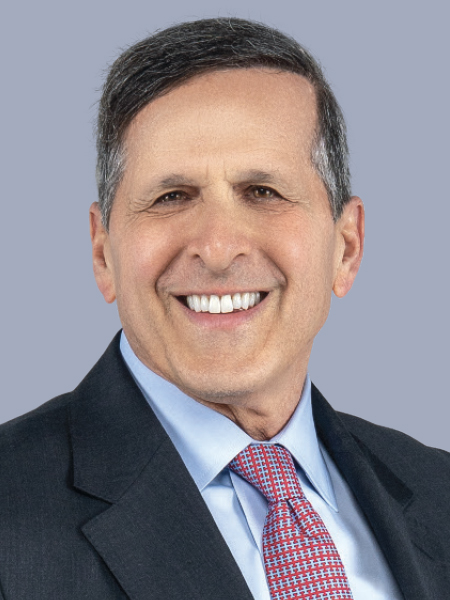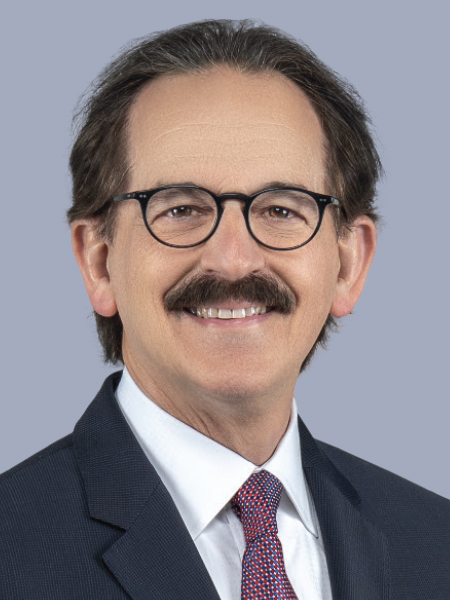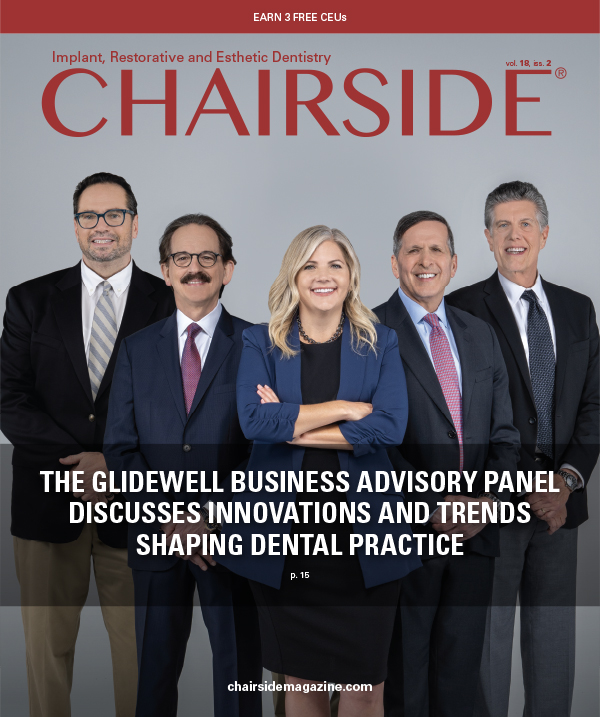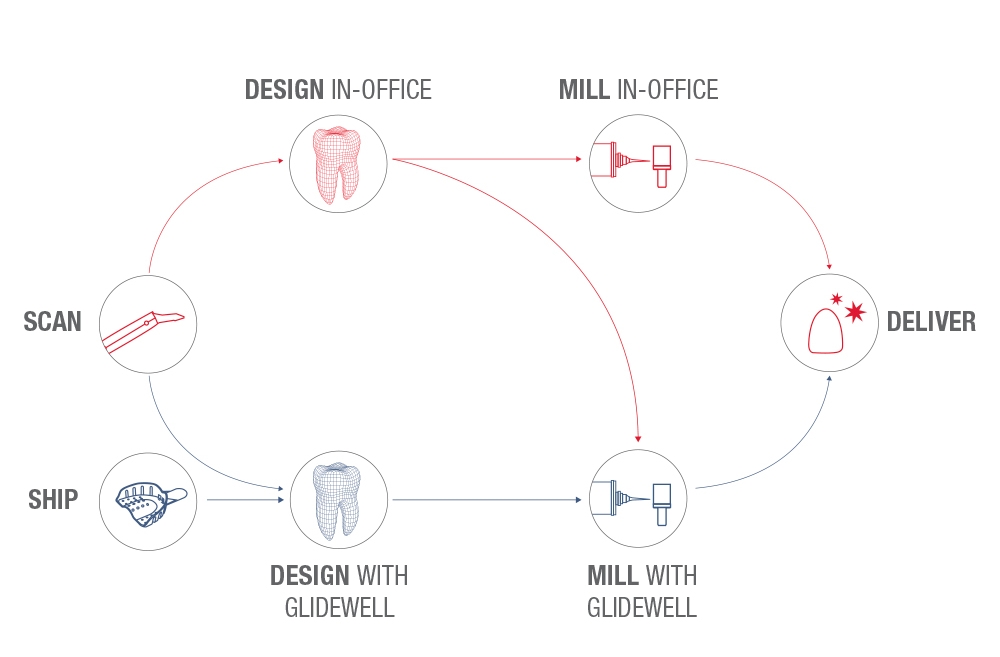The Future of Private Practice: What Successful Dentists Need to Know

The Glidewell Business Advisory Panel. Shown from left to right: David G. Hochberg, DDS, private practitioner; Nikole Smith, RDH, Glidewell online training manager; Neil I. Park, DMD, vice president of clinical affairs at Glidewell; Roger P. Levin, DDS, CEO of Levin Group, Inc.; and Gary Pritchard, J.D., attorney
In March 2020, in response to the COVID-19 pandemic, dentists across the country were required to close their practices and institute extreme measures to protect patients and staff. The Glidewell clinical education team, under the leadership of Dr. Neil Park, vice president of clinical affairs, created the Glidewell Online Study Club as an emergency response to provide immediate and current advice in support of the dental community. Recruiting nationally known experts in accounting, law and dental practice management, a Business Advisory Panel was established to disseminate the advice that was so critical to dental practices.
As restrictions subsided, the study club shifted to a weekly schedule and developed the format that has been maintained for over 170 episodes: Every session begins with a quick visit from the Business Advisory Panel for current business updates, followed by a clinical lecture with a moderated question-and-answer session.
To date, more than 30,000 dentists have participated in these webinars, with a total attendance of more than 135,000. Moreover, the weekly attendance has continued to grow, even beyond the levels during the peak of the pandemic, when doctors were most in need of advice.
For the third anniversary webinar held in April 2023, Glidewell assembled a special panel to offer their unique perspectives on the future of private practice. This article recaps their advice on key success strategies.
PART I: EMBRACING DIGITAL DENTISTRY
Founder and President Jim Glidewell talked about his life-threatening battle with COVID-19, and how he returned to work even more committed to the advancement of dentistry and dental technology. Three years later, the company has experienced tremendous progress in the development of the glidewell.io™ In-Office Solution, as well as in the ability to optimize the growing adoption of digital dentistry in practices around the country. CEO Stephenie Goddard shared some data illustrating that growth:
Artificial intelligence (AI) is also playing a major role in digital dentistry. By developing AI-enabled software like fastdesign.io™, which uses a library of over 20 million crowns to accurately generate designs, Glidewell has already begun harnessing the benefits of machine learning.
Dental practices will gain the ability to choose their preferred workflows. Software like fastdesign.io paired with in-office mills and 3D printers will allow dentists to complete many cases in just one visit. Alternatively, if a restoration requires the expertise of a dental technician, the option is always available to digitally submit the case to the lab. The effectiveness of this technology and these processes will continue to improve, transforming the dental industry into one that can better serve patients at affordable prices.
PART II: CRAFTING A SUCCESSFUL PRACTICE STRATEGY
CHUCK COHEN

Chuck Cohen is managing director and third-generation owner of Benco Dental Company, the nation’s largest independently owned dental distributor with locations in 40 states.
Many dental practices lack a clear strategy and direction, which results in underperformance, both financially and operationally. Almost every dentist has clear goals in mind, but the most successful clinicians are the ones who can share and articulate a strategy with their team.
Unlike mission or vision statements, which tend not to change throughout the life of a practice, practice strategies change based on present circumstances and serve as the “how” for reaching the vision of success. Here are Chuck Cohen’s principles to identify and articulate the best strategy for any practice:
1. Complete an honest SWOT analysis with staff input
SWOT stands for strengths, weaknesses, opportunities and threats. Doctors should focus on leveraging the strengths of their practice to maximize opportunities for success.
2. Get patient feedback
Trusted patients are an invaluable source of feedback. They see the strengths and weaknesses of a practice, confirming the direction of a practice strategy.
3. Write down the strategy
This step should be done as a team. Strategies should start with the words, “We will win by...,” and reflect goals that are realistic and authentic that everybody can get behind and feel motivated by.
4. Post the first draft where staff can see
The reason for posting this is for dentists and staff to revisit often. This allows the entire practice to adhere to and refine the strategy as time goes on.
5. Choose the key performance indicators (KPIs)
Doctors should determine what KPIs best illustrate the progress of a strategy, from financial growth, to patient demographics, to re-appointment numbers. Whatever KPIs get chosen, they should be tracked and posted regularly in the office.
PART III: OPTIMIZING PRODUCTION
ROGER P. LEVIN, DDS

Dr. Roger Levin is the CEO of Levin Group, Inc., a leading dental management consulting firm. Founded in 1985, Levin Group has worked with more than 30,000 dental practices. Dr. Levin has authored 65 books and more than 4,000 articles on dental practice management and marketing.
Most dentists lose roughly $20 million in revenue over the span of a 36-year career. Much of that can be attributed to simple oversights that are leading to a less productive dental practice. When dentists are able to correct those inefficiencies, it is reasonable to reduce retirement age from today’s average of 72 down to 62 — even with rising student loan debt.
Production is the single most important factor in the success of a dental practice, and data shows that almost all practices can increase production by 30%–40% in three to four years. Here are 10 ways to increase practice production and protect profitability:
Reactivate Overdue Patients
Most practices have only 80% of their patients scheduled at a given time for the simple reason that dentists don’t look at this number. For those who would like to increase production in the shortest amount of time, this is the best way.
Streamline Workflow
Software and technology increase efficiency and help dentists delegate more effectively to their staff. Reducing workflow inefficiency can increase patient volume by 15%–20%.
Reduce No-Shows and Last-Minute Cancellations
The target number for this is under 1%. Over a 36-year career, this can result in $4–6 million in potential earnings.
Increase Case Acceptance to 90%
There are many factors to achieving this goal, but having open, honest conversations with patients is the best starting point. When patients feel that they are treated like equals, they are more likely to say yes to dental procedures.
Add New Services
There are many opportunities to learn new skills through continuing education, like through Glidewell Clinical Education. Doctors can start with webinars, online courses and live seminars as the first steps in adding more services to their practices.
Assign a Hygiene Coordinator
Whether it’s part-time or full-time, this person’s role is optimizing the hygienist schedule. Hygiene is profitable, and dentists can maximize this by examining every patient and identifying further patient needs like implants or cosmetic services.
Proactively Address Insurance Cases
There are two times during the year when this is most effective. In September, patients often have remaining benefits and incomplete treatments. In January, patients will have had their benefits reset.
Save 10 Minutes Per Hour in the Schedule
This one is all about optimizing the doctor’s time, which makes up 75% of a practice’s production. By filling in all schedule holes, having highly trained assistants and always using multiple rooms, 99% of practices could add six years of doctor production over a 36-year career.
Increase Staff Longevity
Benefits of better staff care include better work efficiency, more fun in the workplace and overall better patient care.
Increase New Patients
Some might think this is the total solution to increasing practice production, so they spend a lot of money on marketing. In fact, this can be done without spending a dime. Practices can achieve a 20% increase in new patients just through internal marketing and patient referrals.
Along with these strategies for raising practice production, doctors also need to raise their fees to protect profitability.
PART IV: DSO VERSUS PRIVATE PRACTICE – UNDERSTANDING YOUR EARNING POTENTIAL
DAVID G. HOCHBERG, DDS

Dr. David Hochberg operates a general practice in Atlanta that has provided restorative, implant and cosmetic dentistry services for more than 30 years. He is a past president of the AAID and former editor of AAID News.
Dental school graduates today have several options for starting their careers. Working for Dental Support Organizations (DSOs), new dentists now have a way to reliably jump start their careers and gain access to excellent compensation. While this route is popular among younger dentists, it doesn’t necessarily mean that it is the inevitable future — or most profitable way — of working in general practice. The long-term benefits of going into private practice for oneself must be compared against the rewards of an immediate income source.
Dentists must be aware of three common downsides with DSOs. First, practices are often under contract to insurance plans and lose the ability to charge full fee for service. Second, dentists in the early phase of their careers are seeing a high volume of patients — much higher than they would see in a privately owned practice. Some are finding that this early high volume practice can lead to burnout. And third, the diminishment of the doctor-patient relationship and quality of patient care.
For those who would like complete control over their earning power and want to feel the satisfaction of helping lifelong patients and their families, it is worth the commitment to establish a private practice. Here are some of the principles for establishing a relationship-based practice Dr. Hochberg has learned over his very successful 40-year career:
1. Great service starts with a human voice.
There’s nothing more effective than a warm, caring person patients can grow familiar with. People don’t want to interact with a machine, and they always appreciate receiving personal texts and emails to confirm appointments.
2. Put patients on a pedestal.
Making patients feel special goes a long way and can result in higher referral rates and lifelong retention. Go the extra mile — pick up the phone and personally call patients to check on them after a procedure.
3. Always deliver on promises.
At the end of the day, this is a service job. Dentists in private practice depend on patients to survive, so the worst thing to do is make a patient lose trust.
4. Never stop attending CE.
New skills and knowledge translate to better patient care, and there’s always something new to learn or improve on.
By sticking to these core tenets of great customer service, any private practice can flourish and build a strong community of patients. Positive experiences lead to positive referrals, which leads to patients going out of their way and driving past countless other dental offices to get to the one where they feel best cared for. In delaying the immediate gratification of financial gain, private practitioners can experience one of the most gratifying feelings in dentistry — being satisfied and fulfilled by what they do.
Positive experiences lead to positive referrals, which leads to patients going out of their way and driving past countless other dental offices to get to the one where they feel best cared for.











